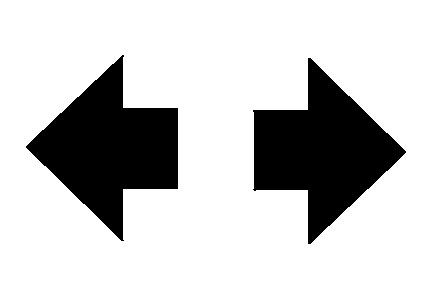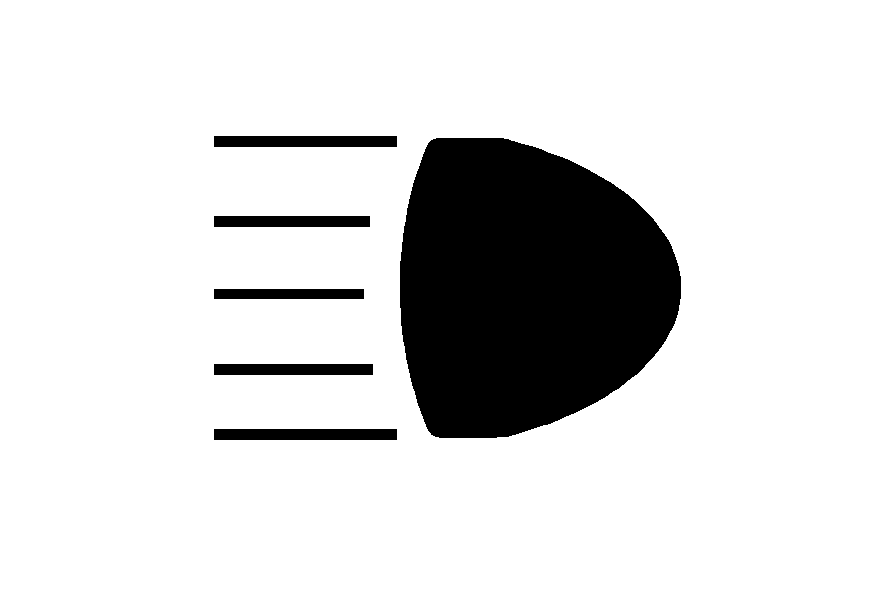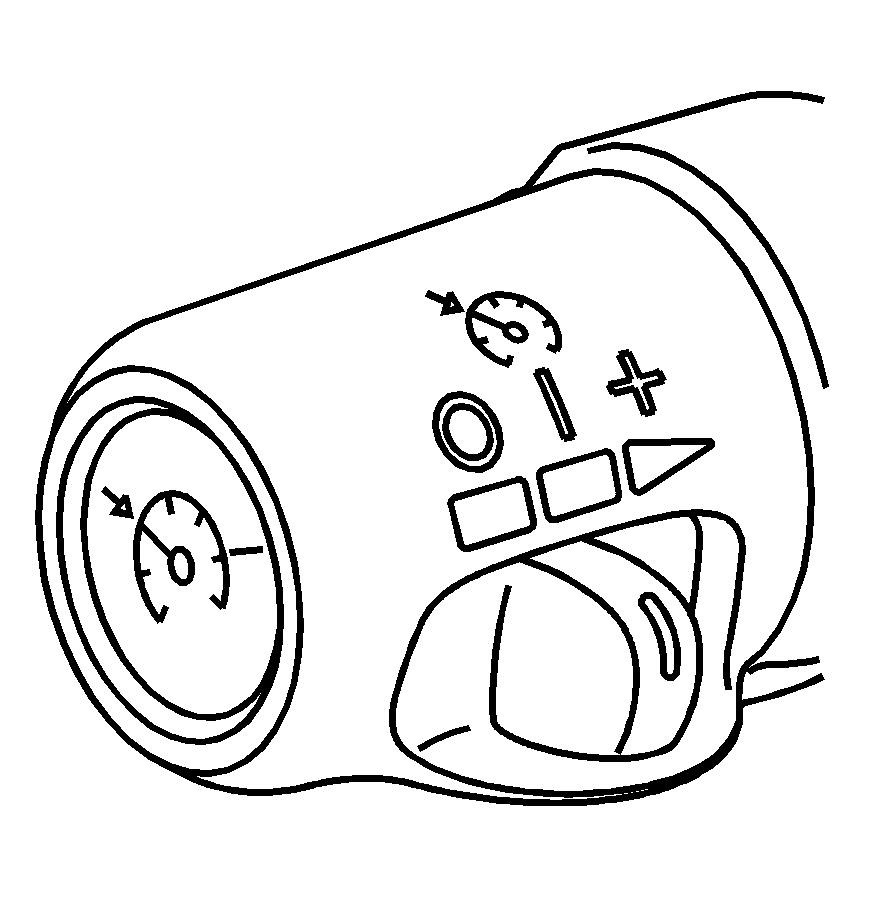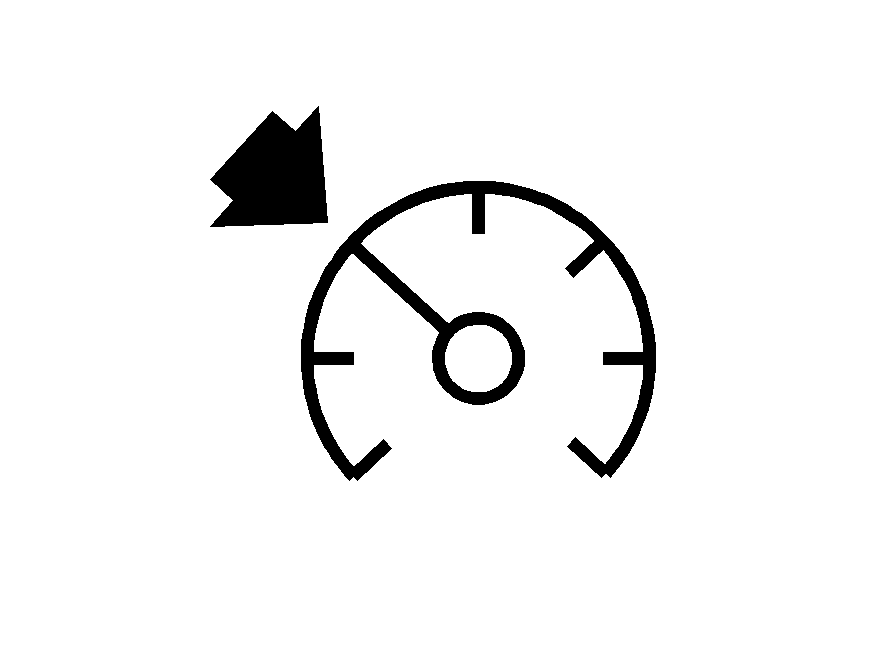
The lever on the left side of the steering column includes the following:
| • | Turn and Lane-Change Signals |
| • | Headlamps |
| • | Headlamp High/Low Beam-Changer |
| • | Flash-To-Pass Feature |
| • | Fog Lamps |
| • | Cruise Control |
For more information on the exterior lamps, see Exterior Lamps .
Turn and Lane-Change Signals
To signal a turn, move the lever all the way up or down. The lever returns automatically when the turn is complete.

An arrow on the instrument panel cluster will flash in the direction of the turn or lane change.
Raise or lower the lever until the arrow starts to flash to signal a lane change. Hold it there until the lane change is complete. The lever returns to its original position when it's released.
Arrows that flash rapidly when signaling for a turn or lane change may be caused by a burned-out signal bulb. Other driver's won't see the signal.
Replace burned-out bulbs to help avoid possible accidents. Check the fuse and for burned-out bulbs if the arrow fails to work when signaling a turn. See Fuses and Circuit Breakers for more information.
Turn Signal On Chime
If the turn signal is left on for about 1 mile (1.6 km), a warning chime will sound and the Turn Signal On message will appear on the Driver Information Center (DIC) display. See "Turn Signal On Message" under DIC Warnings and Messages for more information.
Headlamp High/Low-Beam Changer
Push forward on the turn signal/multifunction lever to change the headlamps from low to high beam. Pull the lever back and then release it to change from high to low beam.

This light on the instrument panel cluster will be on, indicating high-beam usage.
Flash-To-Pass Feature
This feature allows you to use the high-beam headlamps to signal the driver in front of you that you want to pass.
Pull and hold the turn signal/multifunction lever toward you to use this feature. When you do, the following will occur:
| • | If the headlamps are either off, in low-beam or in Daytime Running Lamps (DRL) mode, the high-beam headlamps will turn on. They'll stay on as long as you hold the lever there. Release the lever to turn them off. |
| • | If the headlamps are in high-beam mode, they will switch to low beam. To return to high-beam, push the lever away from you. |
Headlamps
The exterior lamp control is located in the middle of the turn signal/multifunction lever.
(Exterior Lamp Control): Turn the control with this symbol on it to operate the exterior lamps.The exterior lamp control has four positions:
(On/Off): Turn the control to this position to turn off all lamps except the Daytime Running Lamps (DRL).AUTO (Automatic): Turn the control to this position to put the headlamps in automatic mode. AUTO mode will turn the exterior lamps on and off depending upon how much light is available outside of the vehicle.
(Parking Lamps): Turn the control to this position to turn on the parking lamps together with the following:
| • | Sidemarker Lamps |
| • | Taillamps |
| • | License Plate Lamps |
| • | Instrument Panel Lights |
Wiper-Activated Headlamps
This feature activates the headlamps and parking lamps after the windshield wipers have been in use for about six seconds. For this feature to work, the exterior lamp control must be in AUTO.
When the exterior lamp control is off or in the parking lamp position and the windshield wiper control is in any position except off, the Headlamps Suggested message will appear on the DIC display. See "Headlamps Suggested Message" under DIC Warnings and Messages for more information.
When the ignition is turned to OFF, the wiper-activated headlamps will immediately turn off. They will also turn off if the windshield wiper control is turned off.
Headlamps On Reminder
A warning chime will sound if the exterior lamp control is left on in either the headlamp or parking lamp position and the driver's door is opened with the ignition off.
Fog Lamps
Use the fog lamps for better vision in foggy or misty conditions.
The fog lamp control is located on the turn signal/multifunction lever.
: The band with this symbol is used to turn the fog lamps on and off.The parking lamps must be on for the fog lamps to work.
To turn the fog lamps on, turn the fog lamp band on the lever up to the dot and release it. The band will return to its original position.
To turn the fog lamps off, turn the for lamp band up to the dot and release it. The band will return to its original position, and the fog lamps will turn off. If you turn on the high-beam headlamps, the fog lamps will also turn off. They'll turn back on again when you switch back to low-beam headlamps.
Cruise Control

These controls are located on the end of the multifunction lever.
(Off): This position turns the system off.(On): This position activates the system.
+ (Resume/Accelerate): Push the lever to this symbol to make the vehicle resume to a previously set speed or to accelerate when cruise is already active.
(Set/Decrease): Press this button to set the speed or to decrease the speed when cruise is already active.
With cruise control, you can maintain a speed of about 25 mph (40 km/h) or more without keeping your foot on the accelerator. This can really help on long trips. Cruise control does not work at speeds below about 25 mph (40 km/h).
If you apply your brakes, the cruise control will shut off.
Caution: Cruise control can be dangerous where you cannot drive safely at a steady speed. So, do not use the cruise control on winding roads or in heavy traffic.
Cruise control can be dangerous on slippery roads. On such roads, fast changes in tire traction can cause excessive wheel slip, and you could lose control. Do not use cruise control on slippery roads.If your vehicle is in cruise control when the traction control system begins to limit wheel spin, the cruise control will automatically disengage. See Traction Control System (TCS) and StabiliTrak® System . When road conditions allow you to safely use it again, you may turn the cruise control back on.
Setting Cruise Control
Caution: If you leave your cruise control on when you are not using cruise, you might hit a button and go into cruise when you do not want to. You could be startled and even lose control. Keep the cruise control switch off until you want to use cruise control.
- Move the cruise control switch to on.
- Get up to the speed you want.
- Press in the set button at the end of the lever and release it.
- Take your foot off the accelerator pedal.

This light on the instrument panel cluster will come on while cruise control is on.
Resuming a Set Speed
Suppose you set your cruise control at a desired speed and then you apply the brake. This, of course, disengages the cruise control. But you don't need to reset it.
Once you're going about 25 mph (40 km/h) or more, you can move the cruise control switch briefly from on to resume/accelerate.
You'll go right back up to your chosen speed and stay there.
If you hold the switch at resume/accelerate the vehicle will keep going faster until you release the switch or apply the brake. So unless you want to go faster, don't hold the switch at resume/accelerate.
Increasing Speed While Using Cruise Control
There are two ways to go to a higher speed:
| • | Use the accelerator pedal to get to the higher speed. Press the set button at the end of the lever, then release the button and the accelerator pedal. You'll now cruise at the higher speed. |
| • | Move the cruise switch from on to resume/accelerate. Hold it there until you get up to the speed you want, and then release the switch. To increase your speed in very small amounts, move the switch briefly to resume/accelerate. Each time you do this, your vehicle will go about 1 mph (1.6 km/h) faster. |
Reducing Speed While Using Cruise Control
There are two ways to reduce your speed while using cruise control:
| • | Press in the button at the end of the lever until you reach the lower speed you want, then release it. |
| • | To slow down in very small amounts, briefly press the set button. Each time you do this, you'll go about 1 mph (1.6 km/h) slower. |
Passing Another Vehicle While Using Cruise Control
Use the accelerator pedal to increase your speed. When you take your foot off the pedal, your vehicle will slow down to the cruise control speed you set earlier.
Using Cruise Control on Hills
How well your cruise control will work on hills depends upon your speed, load and the steepness of the hills. When going up steep hills, you may have to step on the accelerator pedal to maintain your speed. When going downhill, you may have to brake to keep your speed down. Applying the brake will take you out of cruise control. If you need to apply the brake due to the grade of the downhill slope, you may not want to attempt to use your cruise control feature.
Ending Cruise Control
To end a cruise control session, step lightly on the brake pedal.
Stepping on the brake pedal will end the current cruise control session only. Move the cruise control switch to off to turn off the system completely.
Erasing Speed Memory
When you turn off the cruise control or the ignition, your cruise control set speed memory is erased.
